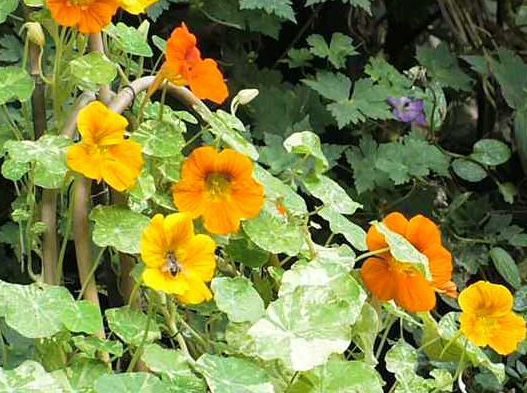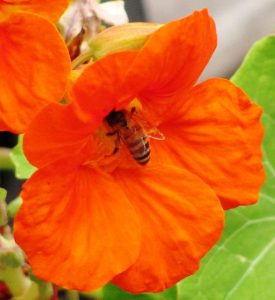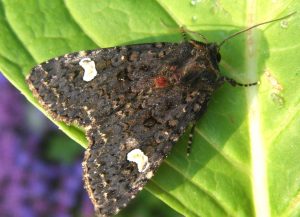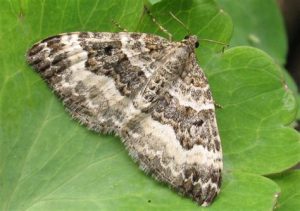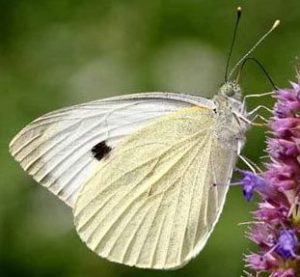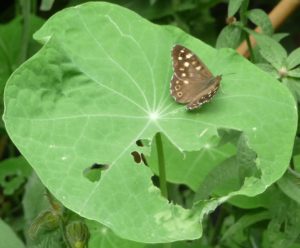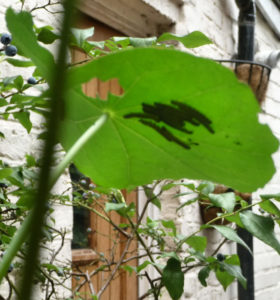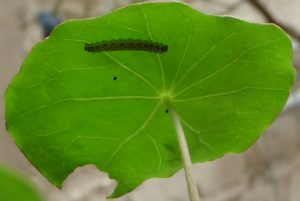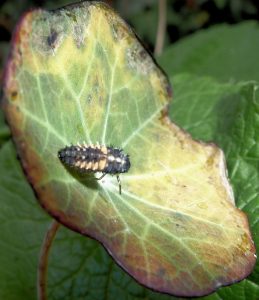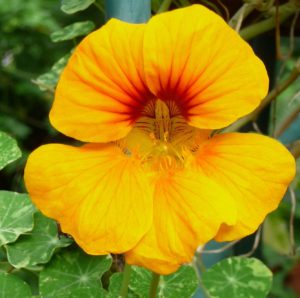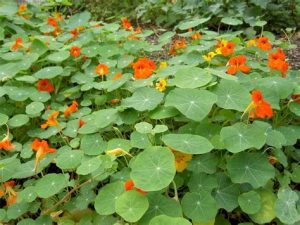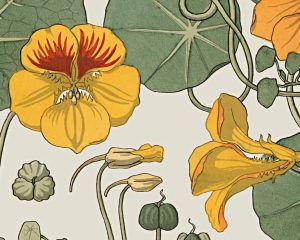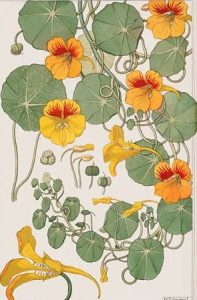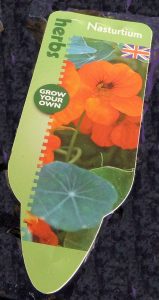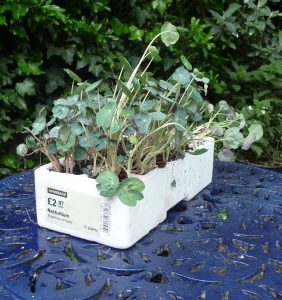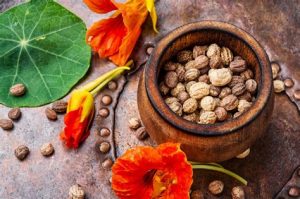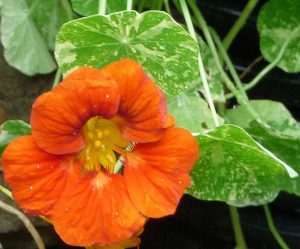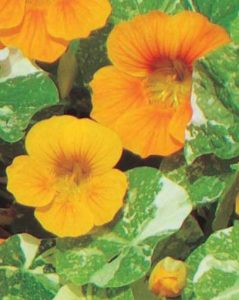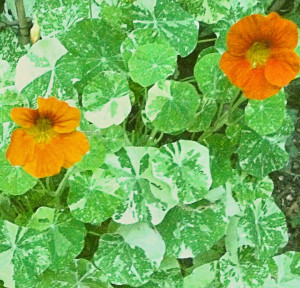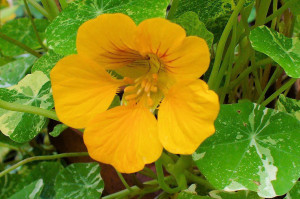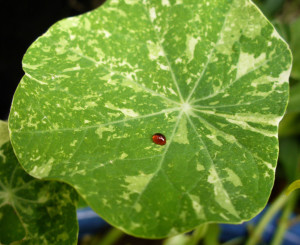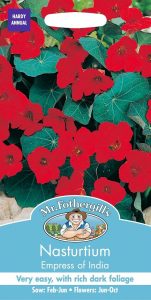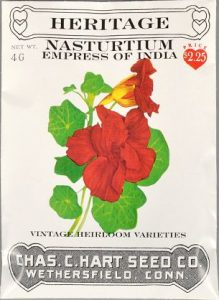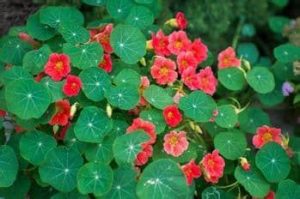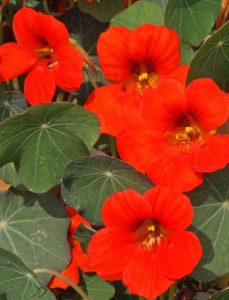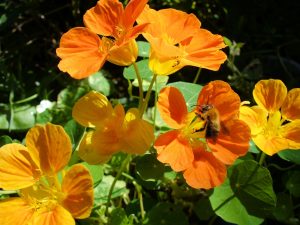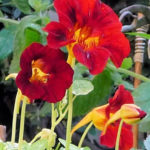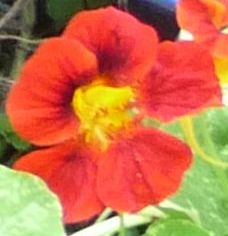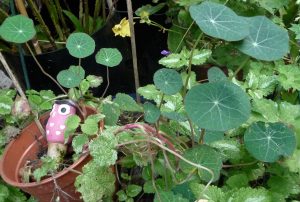NASTURTIUM (Tropaeolum majus) – Indian cress
Chile, Peru, Brazil, Bolivia
Introduced to Europe from Peru in the 16oos, the Nasturtium is now a favourite summer ornamental, flowering from midsummer to first frosts. Perennial in its native countries, it is an annual here.
A generous blanket of disc-shaped leaves is the backdrop for its sumptuous trumpet-shaped flowers in YELLOWS, ORANGES & REDS.
Bees’ Favourite
Tropaeolum’s bright flowers attract the bees, who land on the lower petals, climb inside the flower spur & emerge covered in pollen. Once pollinated the flower bows down with its spur in the air, signalling to pollinators that they must look elsewhere for nectar.
” In its native countries the nasturtium is pollinated by hummingbirds which dip their beaks deep into the spur in order to reach the sweet and slightly pungent nectar.” Nasturtium – Dr Hauschka –
https://www.drhauschka.com/plant-glossary/nasturtium/
Food for Wildlife
Nasturtium leaves are a food plant for the Dot Moth and the Garden Carpet Moth. The plant is used by gardeners to keep caterpillars of the Large White (Cabbage White) Butterfly off their brassicas.
Medicinal & Herbal
In Alsace the nasturtium flowers are added to fermenting wine to impart a particular pungency.” Medicinal Herb Info . http://medicinalherbinfo.org/000Herbs2016/
“According to the daughter of Linnaeus, the blossoms of Nasturtium have been observed to emit electric sparks towards evening. It is seen most distinctly with the eye partly closed.
“Nasturtium was used in folk medicine as a remedy against scurvy, and can be used as a natural, warming remedy to help the body overcome and prevent the common cold and influenza. It was also used traditionally to treat muscular pain, and its antimicrobial properties extend to its use as a topical treatment for bacterial infections and minor scrapes and cuts.” Medicinal Uses of Nasturtium, herbblurb 2017, https://herbblurb.com/2017/09/14/medicinal-uses-of-nasturtium/
Historical
Native to Peru in South America, the Nasturtium grows on the mountain slopes of the Andes Mountains.
“ Nasturtiums came to North America the long way. Discovered in Peru in the 1500’s, two species were taken back to Spain as vegetables. It was a Dutch botanist who took the then short plants and developed the twisting vine Linnaeus named. Soon they were being grown for their flowers as well and spread across Europe. Then they came to North America with immigrants as early as 1759.
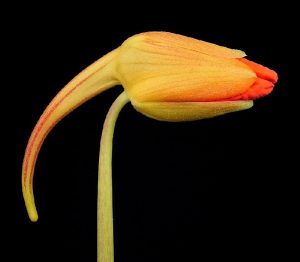 “The French, German and Spanish names of nasturtium all derive from the Italian cappucio hood; especially a monk’s cowl; the name was given because of the resemblance of the spurred flowers to the cowl of a Capuchin monk.
“The French, German and Spanish names of nasturtium all derive from the Italian cappucio hood; especially a monk’s cowl; the name was given because of the resemblance of the spurred flowers to the cowl of a Capuchin monk.
In the Victorian Language of Flowers, floriography, the Nasturtium was said to represent conquest, victory in battle, patriotism. https://sharonlathanauthor.com › floriography-n-o-and-p-flowers
Edible
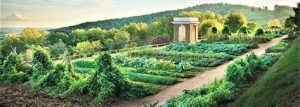 Thomas Jefferson planted nasturtiums in his garden from at least 1774 on. He pickled the seeds and categorized the Nasturtium as a fruit along with the tomato (which is botanically a fruit but legally a vegetable. That came from a US supreme court ruling in the 1890s and involved different taxation rates for fruits, vegetables, and seeds. Since tomatoes — and beans — were used as vegetables rather than fruit and seeds, respectively, they were to be taxed like vegetables.)” Green Deane, Growables, Grow Florida Edibles, From Eat the Weeds and Other things too, www.eattheweeds.com
Thomas Jefferson planted nasturtiums in his garden from at least 1774 on. He pickled the seeds and categorized the Nasturtium as a fruit along with the tomato (which is botanically a fruit but legally a vegetable. That came from a US supreme court ruling in the 1890s and involved different taxation rates for fruits, vegetables, and seeds. Since tomatoes — and beans — were used as vegetables rather than fruit and seeds, respectively, they were to be taxed like vegetables.)” Green Deane, Growables, Grow Florida Edibles, From Eat the Weeds and Other things too, www.eattheweeds.com
The RHS recommends the Nasturtium as one for children to grow; all parts are edible. https://www.rhs.org.uk/education-learning/gardening-children-schools/family-activities/Grow-it-!/grow/nasturtium
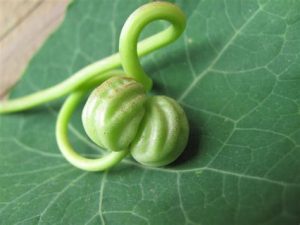 How to Grow Nasturtium from Seed in Containers . Project Diaries . Youtube
How to Grow Nasturtium from Seed in Containers . Project Diaries . Youtube
https://www.google.com/search?client=firefox-b-d&q=project+diaries+++nasturtiums Always excellent hints & tips from Lee at Project Diaries.
How to Grow Nasturtiums – 12 steps, Wiki how https://www.wikihow.com/Grow-Nasturtiums
Easy to Grow
Nasturtium needs no special treatment, no fertilizer… only water & sunshine (the sunniest position produces more flowers). If Blackfly or Greenfly are a problem, & ladybirds or birds not keeping numbers down, spray the plant with a little dilute washing-up liquid. Aphids dislike the slick coating on the leaves. Deadheading blooms that have gone over persuades the plant to produce more flowers.
Nasturtium will struggle to bloom in extreme heat, over 100 degrees F, & does not survive our cold & wet winters, dying with first frosts.
Other names: Blomkarse (Norwegian), Blomsterkarse (Danish), Capuchina (Spanish), Capuchin Monk, Capucine, Cresson d’Inde, Grande Capucine (French), Kapuzinerkresse (German), Koynnoskrassi (Finnish), Lark-heel, Mexican Cress, Monks Cress, Nasturzio (Italian), Nose-tweaker, Nose-twister, Peruvian Cress, The ‘nasties’, Tradgardskrasse (Swedish), Tropaeolum (Dutch).
Our Highbury Nasturtiums
‘Alaska’ has lime green leaves with creamy mottling and flowers in shades of YELLOW and ORANGE
We have also grown Empress of India, with its rich RED flowers and dark, bottle-green leaves.
The YELLOW and ORANGE flowers of ‘Whirlybird’ have no flower funnels, but the bees don’t mind.
My first Nasturtium was grown on a balcony. It had masses of leaves but few flowers; friend Eileen said “You want poor soil! Find yourself some builders’ rubble!” This was good advice. Used soil from house plants, builder’s rubble & grit – the Nasturtium loved it all. Flowers appeared, & many of them. Bumblebees came to the balcony to visit the Nasturtiums. They visited throughout the summer, buzzing slowly from flower to flower, their fur brushing my hands as I tended the plants.
I’ve kept Nasturtiums through London winters by covering their pots in plastic when frost was predicted, & removing it when temperatures rose. By springtime plants were barely ticking over; sunshine & watering revived them.
However, if kept outdoors for too long in freezing conditions, the plants were doomed. Nasturtiums are not hardy enough to survive our winters unless kept indoors, in a greenhouse or conservatory.
2018: 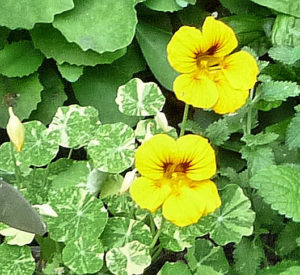 Our Nasturtiums have had a terrible summer. These ‘Alaska’ flowers, a gift from Eda by way of Chapel Market, bloomed before the summer desert heatwave. But there were no further flowers & leaves were tiny, the size of a halfpenny piece. An ‘Empress of India’, too, produced tiny leaves & no flowers for the duration of the heatwave.
Our Nasturtiums have had a terrible summer. These ‘Alaska’ flowers, a gift from Eda by way of Chapel Market, bloomed before the summer desert heatwave. But there were no further flowers & leaves were tiny, the size of a halfpenny piece. An ‘Empress of India’, too, produced tiny leaves & no flowers for the duration of the heatwave.
A Bush Nasturtium & a Trailing Nasturtium made normal leaves but managed no flowers. According to a few websites, including Dave’s Garden, Nasturtiums dislike extreme heat and humidity. Today, 30th August, over a week since the desert heat gave way, we have had one Empress of India flower & another bud… No blooms from the others. It is as if the extreme heat seared away the plants’ memory of how to produce buds and flowers.
2019
This year’s nasturtiums are in a wall basket mounted on the house. 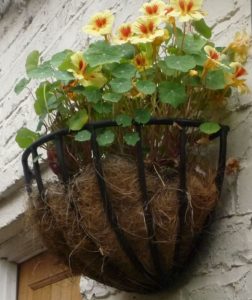
2022
We have had further heatwaves & several unsuccessful Nasturtium years. An attempt to grow them from seed during lockdown failed.
On one youtube gardening programme the gardener, a woman in North Carolina, said Nasturtiums do not like extreme heat… In US summers when other, cooler states are enjoying their Nasturtiums, North Carolinians are sweltering in temperatures of over a hundred degrees fahrenheit & the Nasturtiums are not blooming. We in London have had unseasonable spells of extreme weather for several years now & it does seem that this is not Nasturtium weather… Not the climate of Chile or Peru, or the London of a decade ago…
